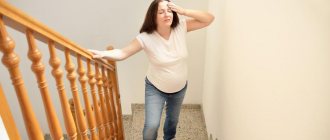Dizziness
It happens that there are no physiological reasons for dizziness. The body, at first glance, is healthy and works great, but the head still feels dizzy again and again. If something similar has happened to you, think about how you felt before the dizziness. Perhaps severe fear or anxiety? Panic? In this case, it is quite possible that your dizziness was psychogenic.
Psychogenic dizziness is dizziness caused by a person's psychological or emotional state. Sometimes it is called imaginary because, unlike true dizziness, it is not associated with a disruption of the vestibular apparatus. [1] Actually, this is why the sensations during attacks of vestibular and psychogenic dizziness are so different: vestibular dizziness is similar to movement, rotation, and psychogenic dizziness is similar to fog in the head, instability, fear of falling, lightheadedness, etc. [2][3]
Despite the fact that psychogenic dizziness occurs due to emotional problems, its symptoms can be very real. For example, shortness of breath, sweating, tinnitus, headache, rapid heartbeat, etc. [1]
How to understand that dizziness is psychogenic?
Only a specialist can find out. During diagnosis, he must, first of all, exclude all other possible causes of dizziness. To do this, he needs to find out from you as much as possible about the conditions under which attacks occur, how long they last and what they look like, whether they are accompanied by other symptoms, etc. In some cases, additional examination by several specialists (otoneurologist, cardiologist, hematologist, etc.), laboratory and radiation diagnostics, as well as additional studies (for example, a study of balance or the condition of the inner ear, ECG, etc.) may be necessary. [2][3]
After the doctor is convinced that you have psychogenic dizziness, you need to understand what kind of disorder caused it. Most often these are [1]:
Anxiety or anxiety-depressive disorders (they are felt as anxiety, constant fears for loved ones, sudden mood swings, worry about little things, tension, stiffness, loss of sleep, decreased performance, increased fatigue, muscle and other pain, etc.) [ 4]
Panic disorder (characterized by recurrent panic attacks and anxiety in anticipation of a new attack). [5] Panic attacks include fear, shortness of breath, palpitations, nausea, weakness, lightheadedness, lightheadedness, fear of falling, and loss of balance. Panic attack is one of the most common anxiety disorders, which approximately 3% of the population has experienced at least once in their lives. [6]
Phobic postural vertigo can be described as a feeling of instability in the form of attacks. Simply put, it feels like a momentary loss of balance. It can occur spontaneously, but is more often associated with specific stimuli or situations that cause fear (i.e., phobias). [4][7]
Hypotension with VSD: how to treat nausea and dizziness in the morning
Dizziness and nausea with vegetative-vascular dystonia are associated with a sharp decrease in blood pressure. This is explained by the inadequate regulation of peripheral vascular tone, as well as venous insufficiency, which often accompanies VSD. It is difficult for a person with low blood pressure to maintain vigor and good health during the day; he has a particularly difficult time with hunger and thirst, is irritable, and inattentive. It takes a lot of effort for a hypotensive person to wake up in the morning and get out of bed. Our recommendations will help facilitate this process and improve your overall condition.
- Morning coffee is the most popular way to slightly increase blood pressure during hypotension. For people with VSD with frequent dizziness and weakness, doctors recommend two to three cups of coffee a day. If you don't have access to coffee, take one caffeine tablet. For arrhythmias and heart failure, which can also be accompanied by low blood pressure, coffee and products containing caffeine are contraindicated.
- Pouring your feet with cold water. You can tone up with a cold shower below your knees. A cold shower in your legs will help your veins contract and return more blood to your upper body, meaning you won't feel dizzy from low blood pressure. It's a pity that this simple method cannot help maintain normal blood pressure all day long. To reduce the likelihood of dizziness during the day with dystonia, regular cool foot baths in the morning and before bedtime are recommended.
- Gymnastics in bed. If morning exercises make you want to lie down as soon as possible, then exercises while lying in bed are what you need. Orthostatic collapse with VSD most often occurs immediately after waking up, when a person tries to jump up at the alarm clock. Several exercises in a lying position will activate blood circulation and restore muscle tone to the vessels of the legs. No tricks: lying on your back, stretch your arms and legs in opposite directions as hard as you can, rotate your feet, do the “bicycle” exercise for 30 seconds, roll over onto your stomach and bend your back, clasp your ankles with your hands and rock back and forth for 30 seconds, stretch forward first one hand, then the other. After this, sit on the bed and stay in this position for about a minute.
- Freshly squeezed orange juice immediately after waking up. This method is suitable if you have normal or reduced acidity of gastric juice. For frequent heartburn and stomach pain, drink 150-200 ml of water with a squeeze of lemon. This way you will immediately replenish your blood volume and it will be easier to keep your blood pressure at an acceptable level. Vitamin C from an orange (in smaller quantities from a lemon slice) activates the sympathoadrenal system, and the second mechanism of increasing blood pressure will work.
An increase in the level of glutathione in the body, a strong endogenous antioxidant, the deficiency of which is associated with the development of vegetative-vascular dystonia. You can activate the synthesis of glutathione by taking amino acids, from which it is formed as a result of a biochemical reaction inside cells: glutamic acid, cystine, glycine. The drug Eltacin® contains three essential amino acids in an optimal ratio and is recommended as the main medicine for dystonia.
Treatment of psychogenic dizziness
Many doctors deal with the problem of dizziness, but when treating psychogenic dizziness, consultations with a neurologist and psychotherapist are especially important.
Typically, complex therapy is used to treat psychogenic dizziness, which includes both medicinal (including antidepressants) and non-medicinal treatment methods. [5] Of great importance are:
• vestibular gymnastics, which is aimed at training and reducing the excitability of the vestibular apparatus; [7]
• breathing exercises, which help reduce hyperventilation (its manifestations include lack of air, dissatisfaction with inhalation, inability to take a full breath, etc.);
• psychotherapy.
It has long been proven that a person’s psychological health is as important as physiological health. [4] Keep this in mind and be sure to consult a specialist if you feel dizzy.
Treatment
Treatment of PPPG should begin with explaining to the patient his diagnosis and the reasons for the formation of this condition.
This provides the confidence necessary to introduce treatment options such as physical therapy, medication, psychotherapy and various types of vestibular rehabilitation. Cognitive behavioral therapy (CBT) has proven itself well [4, 15]. Therapy is based on the collaboration between therapist and patient. The basis of treatment is the process of conceptualization - understanding the situation of a particular patient (personal beliefs and behavioral patterns). The therapist looks for different ways to achieve cognitive changes—modifications in the patient's system of thinking and behavior—that will help prompt lasting emotional and behavioral changes. The key to success is the active participation of the patient, who will not only work during the sessions, but also do homework. The patient and the therapist explore under what circumstances the problem manifests itself: that is, CBT teaches patients to identify, evaluate, and respond to their dysfunctional thoughts and beliefs. The goal is to make a list of moments and situations that cause anxiety/dizziness, etc. Then the therapist and patient outline a work program. It may include tasks that need to be completed in places or circumstances that cause anxiety/dizziness (riding an elevator, eating in a public place, etc.). These exercises allow you to reinforce new skills and gradually change behavior. A person learns to be less rigid and categorical, to see different facets of a problem situation [4]. Guided self-monitoring, which enables patients to recognize excessive postural control at the physical, emotional, and psychological levels, is the first step toward overcoming maladaptive cognitive-behavioral mechanisms. Desensitization exercises can be used to increase tolerance to existing imbalances. Identifying and assessing emotional and cognitive reactions to dizziness can help reduce fear, agitation, and catastrophic thoughts. Over time, patients can train the ability to respond to dizziness with calm.
Vestibular rehabilitation is an umbrella term for a range of physical interventions that aim to compensate and restore the systems that control balance. In PPPD and similar conditions, the main focus of the work is on the principle of desensitizing the balance control systems that operate on "high alert" through habituation exercises and relaxation techniques. A wide range of exercises can be used in vestibular rehabilitation, including both general ones, such as walking programs (gradually increasing the number of steps, speed and duration of walking), and more specific ones that increase dizziness when performing special head movements that must be performed relatively slowly [4]. ].
There are differences in the selection of vestibular rehabilitation methods for patients with PPPG compared to patients with structural vestibular disorders. Exercises with patients with PPPG should be started more carefully and the motor pattern should be expanded more slowly. However, patients should be instructed to begin exercise gradually and increase it slowly but steadily. An exercise program that is too aggressive can worsen symptoms, causing patients to “take a few steps back” before they can achieve any results. Monitoring the implementation of the rehabilitation program for the purpose of timely correction should be carried out by an experienced otoneurologist [4, 16].
To help reduce sensitivity to visual stimuli, there are special exercises, for example, the patient can spin a large striped umbrella in front of his eyes while sitting and then standing for 2 minutes. When treating functional gait disorder, exercises will include distraction techniques (eg, doing simple mental tasks while walking) as well as other types of walking (eg, backward walking, running, crawling) with a gradual return to normal walking. For all of the above, it is recommended to combine supervised treatment with daily unsupervised exercise at home [4, 13].
Selective serotonin reuptake inhibitors and selective serotonin-norepinephrine reuptake inhibitors are well established in the treatment of patients with PPPG. The effectiveness of therapy with drugs of these two classes has been confirmed by several prospective, open-label clinical trials. Randomized controlled trials have not yet been conducted. Dose selection should be done slowly. Effects are typically seen with doses in the lower half of the ranges recommended for treating depression. As with many functional disorders, patients may be particularly sensitive to side effects, leading to treatment interruption in one in five patients during the trial. Clinical response is usually observed after 8-12 weeks and, if a positive result is obtained, treatment should be continued for at least 1 year. Clinical experience with other classes of antidepressants has not been promising. Separately, it is worth noting the recommendation to avoid, if possible, the prescription of vestibular suppressors, such as antihistamines and benzodiazepines [4, 7, 12].
PPPG researchers suggest that long-term benefit likely depends on early treatment. The long course of the disease leads to a higher degree of maladaptation, more severe disability and more ingrained pathological attitudes towards the disease. Patients may suffer from PPPD for many years without being properly diagnosed, so practitioners should be familiar with functional vertigo and be aware of the treatment options described above. The presence of symptoms for a long time does not exclude good treatment results [4, 15].
Functional and psychiatric disorders causing vestibular symptoms (dizziness and/or unsteadiness) are more common than many known structural vestibular disorders. Patient education, vestibular rehabilitation, and medication significantly reduce morbidity and potentially maintain the patient in remission [7].
The authors declare no conflict of interest.
The authors declare no conflicts of interest.
Information about authors
Kunelskaya N.L.
- https://orcid.org/0000-0002-1001-2609; e-mail
Baibakova E.V.
- https://orcid.org/0000-0002-3430-6273; e-mail
Zaoeva Z.O.
- https://orcid.org/0000-0002-2501-0200; e-mail
How to quote:
Kunelskaya N.L., Baibakova E.V., Zaoeva Z.O. Psychogenic dizziness. Journal of Neurology and Psychiatry. S.S. Korsakov.
2019;119(10):89-93. https://doi.org/10.17116/jnevro201911910189
Corresponding author:
Zaoeva Zarina Olegovna — e-mail
Bibliography:
1. Filatova E. G. Diagnosis and treatment of psychogenic dizziness // Attending physician. –2009. - No. 5/9. — https://www.lvrach.ru/2009/05/9155798/ (Access date: 07/18/2016).
2. Drapkina O.M., Chaparkina S.M., Ivashkin V.T. Dizziness in the practice of an internist // Cardiovascular therapy and prevention. – 2007. – No. 6 (4). – pp. 107-114.
3. Zamergrad M.V. Vestibular vertigo // Neurology, neuropsychiatry, psychosomatics. – 2009. – No. 1. – P. 14-18.
4. Sitdikova A.I. et al. Psychogenic dizziness: clinical features and diagnostic principles // Bulletin of modern clinical medicine. – 2015. – T.8. — No. 6. – pp. 76-79.
5. Filatova E. G. Anxiety in neurological practice // Lech. nervous bol. – 2005. – No. 1. – P. 7–14.
6. Melnikov A. N., Stanko E. P. Panic attacks in children and adolescents // Journal of the Grodno State Medical University. – 2005. – No. 3 (11). – pp. 33-35.
7. Golubev V.L., Vein A.M. Neurological syndromes. – M.: Eidos Media, 2002. – 832 p. – pp. 695–704.










